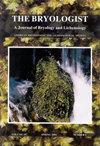A new liverwort and hornwort flora for the northern Andes
IF 0.8
4区 生物学
Q4 PLANT SCIENCES
引用次数: 0
Abstract
In May 2021, the liverwort and hornwort flora of Colombia and Ecuador was finally published. After being delayed twice, certainly due to the Covid-19 pandemic, it was eagerly received and could be called an opus magnum of a long career in hepaticology. Having worked and published for over 50 years in this field, the author of this flora, S. Robbert Gradstein, is an accomplished bryologist on an international level and considered the foremost expert on Neotropical liverworts. This rather sizable book, with over 700 pages, is divided into several parts, starting with a brief introduction and a chapter on diversity and endemism. A classification precedes the taxonomic treatment, which, with about 620 pages, is the most extensive segment occupying the bulk of the book. A glossary, references, and an index to scientific names conclude the flora. The reviewer’s assessment of this book is from an Ecuadorian point of view; his knowledge of the Colombian aspects of this publication is limited. Evaluating such an extensive work like the present one is a tedious task, and hardly all observations can be referred to on a few pages; therefore, the comments are limited to some examples. In the abbreviations section, two of the twentyfour provinces of Ecuador are missing and do not appear throughout the book. In the case of Santa Elena, it might be understandable since probably neither collections nor reports of liverworts and hornworts from that province exist. For Santo Domingo de Los Tsáchilas, however, at least some liverwort species are documented; see Burghardt (2021) for a brief discussion. The classification follows Söderström et al. (2016) with minor deviations, like the distinction of Adelanthaceae and Jamesoniellaceae, the inclusion of Anastrophyllaceae in Scapaniaceae, and Southbyaceae in Arnelliaceae, among others. The taxonomic treatment comprises keys and descriptions of about 850 species, consisting of 830 liverworts and 20 hornworts, including the proposal of about a dozen new combinations, species, and subspecies. Furthermore, treatments of several genera like Acrobolbus, Lejeunea, and Lophocolea, among others, are revised. A broad morphological species concept is presented throughout the book, reflected by the proposal of about 100 new synonyms. Seventy plates illustrate almost all genera and about half of the species. Generally, the keys work well. However, the key to the Plagiochila species, including over 100 couplets, is very complex and, at times, challenging to use. Maybe this is owed to the sixty-five species involved and the extreme morphological plasticity of some common species, which key out several times. Nevertheless, it is unclear why the author did not break this key down into several shorter keys as he has done with Lejeunea, a similarly specious genus. There exists conflicting information on the status of Gongylanthus oniscoides (Spruce) Steph.安第斯山脉北部一个新的苔草和角草区系
2021年5月,哥伦比亚和厄瓜多尔的苔草和角草植物群终于出版。在被推迟了两次之后,当然是由于新冠肺炎大流行,它受到了热烈的欢迎,可以被称为肝脏学长期职业生涯的代表作。该植物区系的作者S.Robbert Gradstein在该领域工作和发表了50多年,是一位在国际层面上颇有成就的苔藓学家,被认为是研究新热带苔类最重要的专家。这本相当大的书有700多页,分为几个部分,首先是简介和关于多样性和地方性的一章。分类先于分类处理,分类处理约620页,是占据本书大部分篇幅的最广泛的部分。一个术语表,参考文献,和一个科学名称索引总结了植物区系。评论家对这本书的评价是从厄瓜多尔的角度出发的;他对本出版物哥伦比亚方面的了解有限。评估像现在这样广泛的工作是一项乏味的任务,几乎所有的观察都可以在几页纸上参考;因此,评论仅限于一些例子。在缩写部分,厄瓜多尔二十四个省中的两个省缺失,也没有出现在整本书中。以Santa Elena为例,这可能是可以理解的,因为该省可能既不存在苔类和角类的收藏也不存在报告。然而,对于圣多明各-德-洛萨奇拉斯,至少有一些苔草物种被记录在案;参见Burghardt(2021)的简短讨论。该分类遵循Söderström等人(2016)的说法,但有一些细微的偏差,如阿德兰科和詹姆逊菌科的区别,将番石榴科纳入Scapaniaceae,将Southbyaceae纳入Arnelliaceae等。分类学处理包括大约850个物种的关键和描述,包括830个苔类和20个角类,包括大约十几个新组合、物种和亚种的建议。此外,对Acrobobus、Lejeunea和Lophocolea等几个属的处理方法进行了修订。全书提出了一个广泛的形态物种概念,大约100个新同义词的提出反映了这一概念。70个图版显示了几乎所有属和大约一半的物种。总的来说,钥匙很好用。然而,Plagiochila物种的钥匙,包括100多对对联,非常复杂,有时使用起来很有挑战性。也许这要归功于所涉及的六十五个物种,以及一些常见物种的极端形态可塑性,这些物种多次出现。尽管如此,目前尚不清楚作者为什么没有像对待Lejeunea(一个类似的似是而非的属)那样,将这把钥匙分解成几个更短的钥匙。关于山云杉的地位,存在着相互矛盾的信息。
本文章由计算机程序翻译,如有差异,请以英文原文为准。
求助全文
约1分钟内获得全文
求助全文
来源期刊

Bryologist
生物-植物科学
CiteScore
2.40
自引率
11.10%
发文量
40
审稿时长
>12 weeks
期刊介绍:
The Bryologist is an international journal devoted to all aspects of bryology and lichenology, and we welcome reviews, research papers and short communications from all members of American Bryological and Lichenological Society (ABLS). We also publish lists of current literature, book reviews and news items about members and event. All back issues of the journal are maintained electronically. The first issue of The Bryologist was published in 1898, with the formation of the Society.
Author instructions are available from the journal website and the manuscript submission site, each of which is listed at the ABLS.org website.
All submissions to the journal are subject to at least two peer reviews, and both the reviews and the identities of reviewers are treated confidentially. Reviewers are asked to acknowledge possible conflicts of interest and to provide strictly objective assessments of the suitability and scholarly merit of the submissions under review.
 求助内容:
求助内容: 应助结果提醒方式:
应助结果提醒方式:


